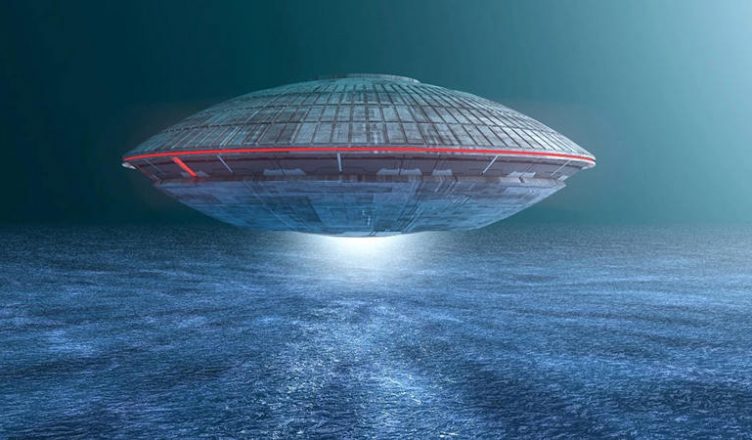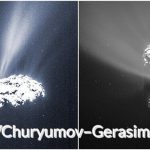In the third year of the Kyowa era (1803), a disc-shaped sailing object drifted to the coast of Hitachi Province (Ibaraki Prefecture), Japan. Inside, a beautiful woman was found holding a box, dressed in unfamiliar clothing. She did not speak Japanese, and mysterious characters were written on the ship. Tales of such “Hitachi Province Utsuro-bune marvel” can be found in various documents from the Edo period. The question remains: was there truly a bizarre drifting event behind these stories? Kazuo Tanaka, an honorary professor at Gifu University, has been devoted to the study of “Utsuro-bune” for many years. Why did he delve into this research field so different from his expertise in optical information engineering?
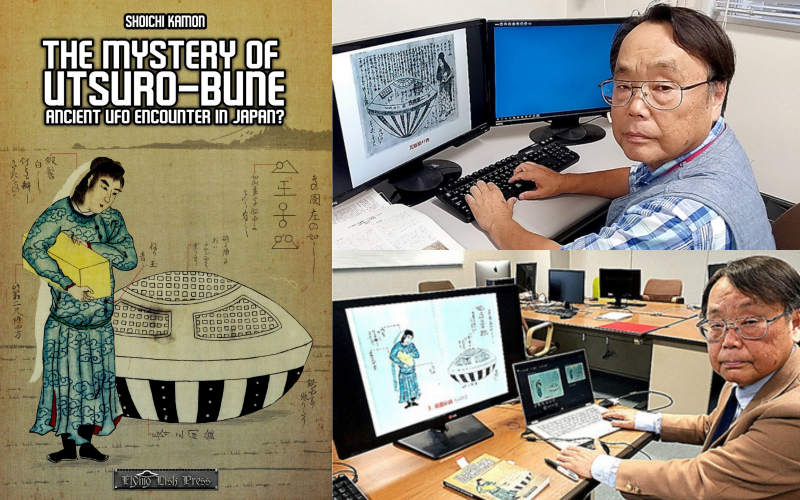
A tangible mysterious event
The initial trigger was the 1995 Aum Shinrikyo incident. This cult gained prominence due to the prophecies and miraculous events, including levitation, claimed by its leader Shoko Asahara. Many high-ranking members of the cult were elite scientists. So, to encourage students to scientifically explore so-called ‘supernatural phenomena,’ I started teaching relevant courses at the university and began collecting various data as teaching materials, such as UFO reports from the United States or folklore stories from Japan. It was during this process that I encountered the legend of ‘Utsuro-bune,'” said Tanaka. “In the Edo period, descriptions of sailing objects resembling flying discs appeared in Japanese literature, even earlier than UFO legends in the United States. I found it fascinating.
The first public attention towards UFOs came in the “Arnold incident” on June 24, 1947, when businessman Kenneth A. Arnold reported seeing “flying saucer-like objects.” Subsequently, various sightings were reported worldwide, with the most famous being the “Roswell incident” near Roswell, New Mexico, in July 1947. “However, the alleged recovered UFO debris and extraterrestrial bodies were reportedly missing, leaving only vague testimonies from witnesses. Unlike this, all UFO information worldwide is considered ‘non-physical mysterious phenomena.’ Yet, the legend of ‘Utsuro-bune’ can be meticulously investigated through several ancient texts, making it a ‘tangible mysterious event’ in the sense that it provides researchers with physical evidence,” Tanaka explained.
The Koga Ninja pinpointed the specific landing location.
During the Edo period, similar “Utsuro-bune” (also known as “Hollow boat” or “Utsuro-fune”) legends were recorded throughout Japan. In Tanaka’s focused study of the phenomenon, he examined several ancient texts that explicitly detailed events occurring in 1803 (though the dates in various sources vary) on the coast of Hitachi Province (present-day Ibaraki Prefecture). These texts included illustrations depicting a beautiful woman and a mysterious sailing object.
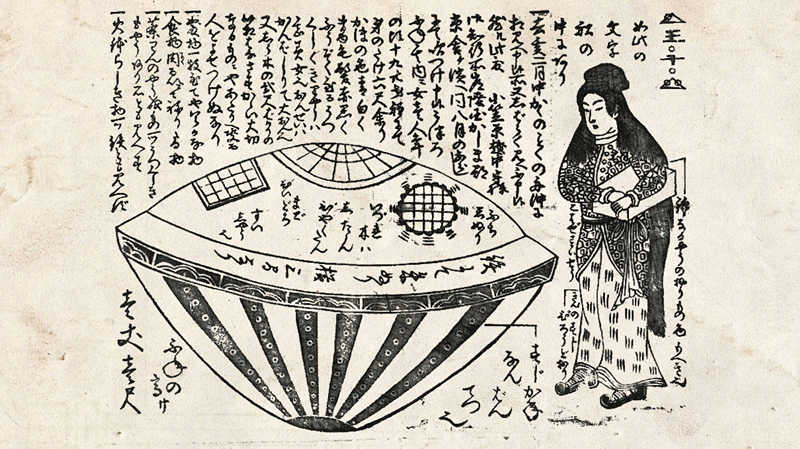
Among these texts, two well-known works are “兔园小说” (1825) compiled by Kuritate Bakin, the author of “Nanso Satomi Hakkenden,” from the literary society “Usagi Enkai,” and “梅の塵” (1844) by Nagahashi Yijiro. Other relevant sources include “鶯宿雜記,” and “弘賢隨筆,” documenting instances of foreign ships drifting to Japan and Japanese individuals drifting abroad in the collection “漂流紀集.”
Tanaka’s initial hypothesis suggested that the legend might have originated from a shipwreck involving Russian whaling vessels, later embellished and passed down through generations. However, he struggled to find any official documentation supporting records of such a shipwreck. Instead, he discovered various new pieces of evidence, leading him to delve into the diverse origins behind the legend of “Utsuro-bune.” To date, Tanaka has identified 11 documents related to the Hitachi Province Utsuro-bune legend. Two of these documents stand out with particularly intriguing hypotheses, both claiming to be records from the year 1803.
One of these documents is the “水戶文書” held by a collector of ancient texts residing in Mito City, Ibaraki Prefecture. Tanaka noticed that the attire of the woman depicted in the illustrations closely resembled the clothing worn by the deity “蚕灵尊” in the “星福寺” temple in Hitachi City, Ibaraki Prefecture, known for sericulture faith. The region already has a legend about the origin of sericulture, known as the “Golden Princess Legend,” where the temple’s Buddha image is modeled after the Golden Princess. According to the legend, the Golden Princess drifted from India to Hitachi Province in a boat shaped like a silkworm cocoon, taught sericulture techniques as gratitude to a local couple, and then ascended to the heavens. Among the 11 documents Tanaka found, only the “Mito Monjo” illustration closely resembled the Golden Princess. Therefore, Tanaka suggests that this may have been used by the people of Seifuku-ji to adapt the Utsuro-bune rumor for temple promotion when it spread around Kashima Beach.
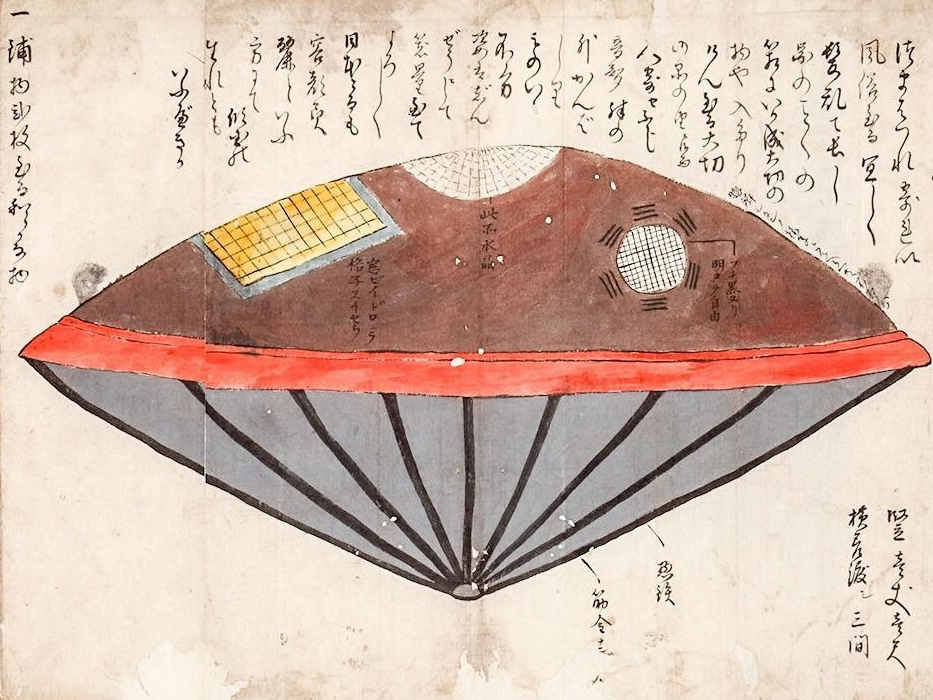
The other crucial document is the “伴家古文書” held by Jinchiro Kawakami, a practitioner of Koga-ryu Ninjutsu. While other documents mentioned vague landing locations such as “Harayadori” within the estate of “Ogasawara Echizen no Kami” (Note: The term “Echizen no Kami” refers to a feudal lord’s estate), the “伴家古文書” specifically mention the actual location “Hitachihara Yadoshima.” This place name is also recorded in the “Ino Map,” a map surveyed by Tadashi Ino in 1801, corresponding to present-day Shirahama, Kashima City, Ibaraki Prefecture. Tanaka noted discrepancies in other documents, with no mention of Ogasawara Echizen no Kami’s estate near Kashima Beach. However, the “伴家古文書” lacked the name Ogasawara but instead mentioned a real location. Upon consulting with Mr. Kawakami, it was suggested that the 伴家古文書 (Koga Ninja) might have collected this information for the convenience of the Owari domain lord during the “Sankei-kotai” process. If so, the authenticity of the document is likely high and cannot be considered a fabrication.
Disc-shaped Boat and Mysterious Inscriptions
The folklorist Kunio Yanagita once asserted that the Utsuro-bune legend was a baseless, artificially created narrative. However, according to Tanaka, “the Utsuro-bune legend in Hitachi Province differs significantly from stories circulating in various parts of Japan.” He continued, “Firstly, it distinctly records the occurrence time: 1803. Secondly, all the documents provide concrete depictions and explanations of the disc-shaped sailing object. This is quite peculiar, and I have a feeling that it might be based on some real-life events. However, during the period of national isolation, if there were shipwrecks involving foreign vessels or foreigners drifting ashore, it would have been a significant event, likely prompting officials to conduct investigations and leave official records. In fact, in 1824, an incident occurred in Otsuhama (Kitasenri, Ibaraki City) involving a British person landing, contributing to the issuance of a ban on foreign ships the following year. From this, it is evident that people might have briefly witnessed something along the Kashima Beach coast, possibly blending with the earlier Utsuro-bune legend.”
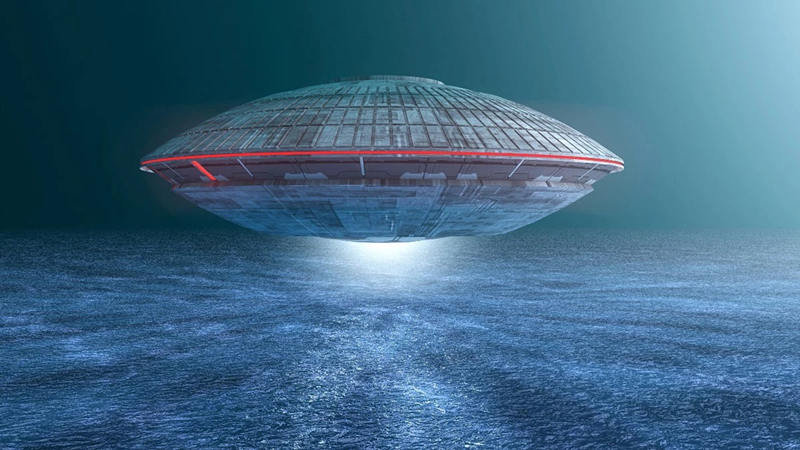
Just as the clothing of the woman in the documents varies, the shapes and sizes of the disc-shaped sailing objects she rode on also differ. For example, according to the “Hyoryuki-ki,” the object she rode was 11 feet tall (approximately 3.3 meters), 3 ken wide (approximately 5.4 meters), made of rosewood and iron, and had windows of glass and crystal. “Currently, it cannot be confirmed whether the ‘Hyoryuki-ki’ is an official document. Within the existing two volumes, apart from the Utsuro-bune, almost all events are verified incidents. From this, we can infer that at least the person who wrote this document considered the event of Utsuro-bune drifting ashore to be a genuine occurrence,” Tanaka confidently stated.
The enigma of Utsuro-bune remains endless, and the cryptic inscriptions inside the boat continue to pique curiosity. Tanaka remarked, “Some theories suggest that it resembles the ‘Ranji-kaku’ (decorative text frames used in Edo-period ukiyo-e prints), so it might simply be for decorative purposes. However, of course, the probability of finding evidence in the future that these are extraterrestrial scripts is not zero,” Tanaka said with a smile. “I believe that in the future, more unknown Utsuro-bune-related documents will be unearthed, bringing new discoveries. The ability to make various hypotheses is what makes this legend fascinating. Japan has such a rich and interesting history and culture, with this legend predating the birth of UFO legends by over 140 years, which once again makes me deeply appreciate Japan’s richness.”
END:
The Utsuro-bune incident of 1803 stands as a captivating enigma, weaving together elements of maritime mystery, folklore, and historical intrigue. While scholars like Professor Kazuo Tanaka continue to delve into the depths of this ancient tale, the precise origins and meaning of the disc-shaped vessel and its mysterious inscriptions remain elusive. The Utsuro-bune legend persists as a testament to the rich tapestry of Japan’s history and culture, inviting us to ponder the possibility of encounters with the unknown that may have unfolded along the shores of Hitachi Province. As new discoveries emerge and interpretations evolve, the Utsuro-bune mystery continues to stir the imagination, leaving us with an enduring fascination for the secrets that lie within the currents of time.
More UFOs and mysterious files, please check out our YouTube channel: MysFiles
Lacerta Files: Human beings are the product of genetic engineering by alien civilizations.
